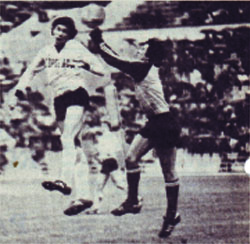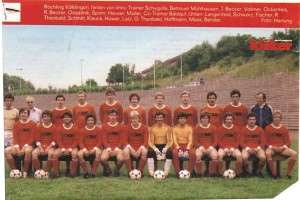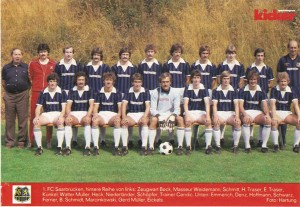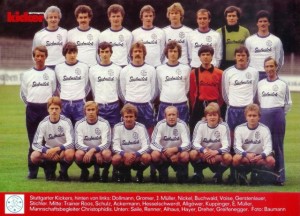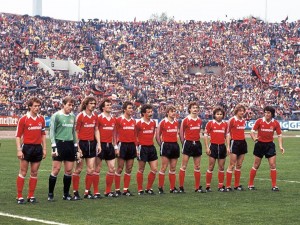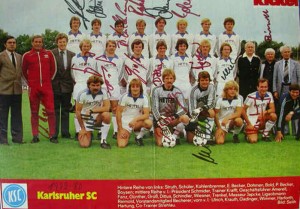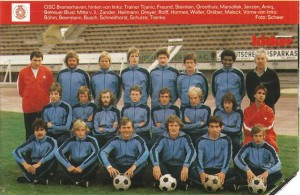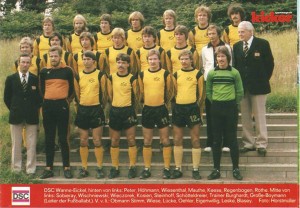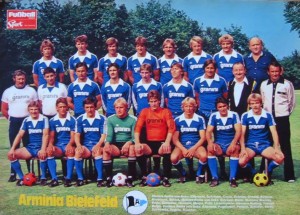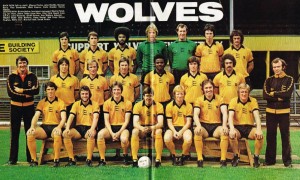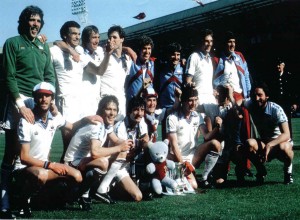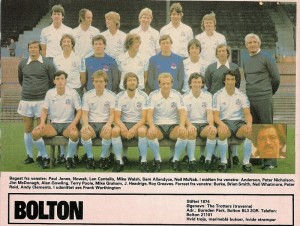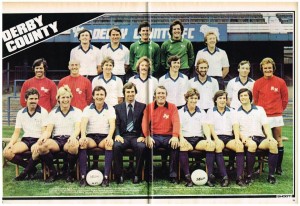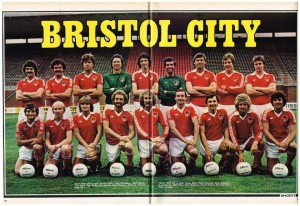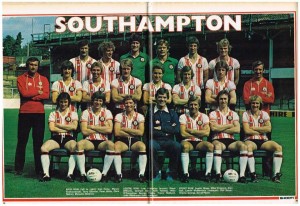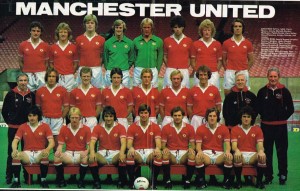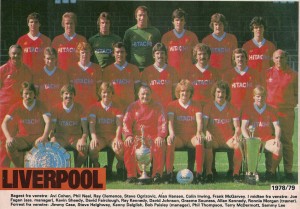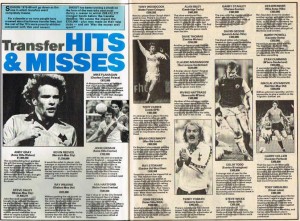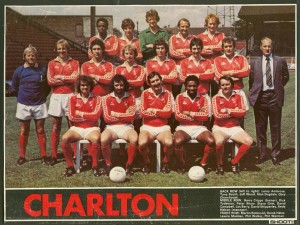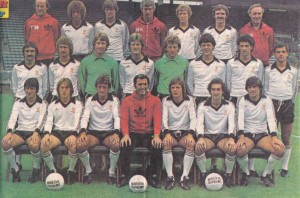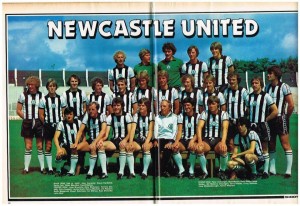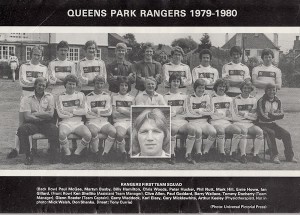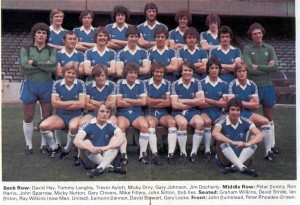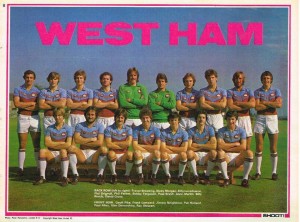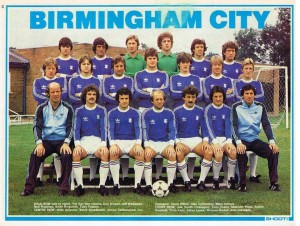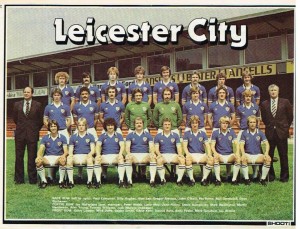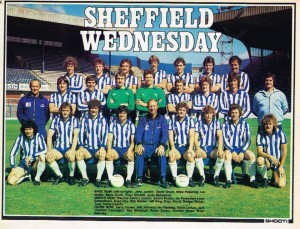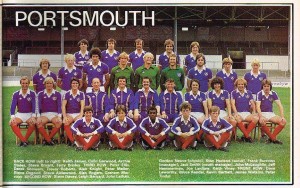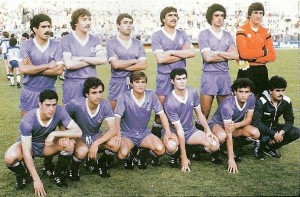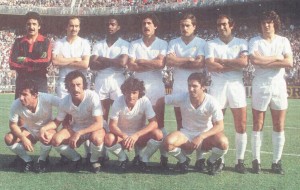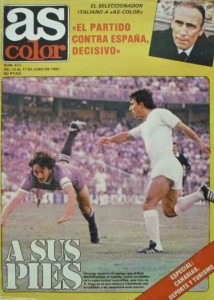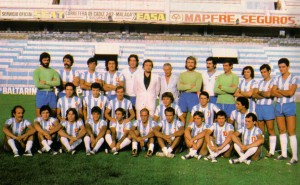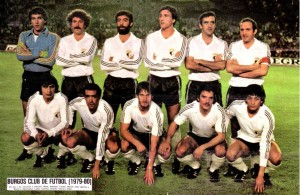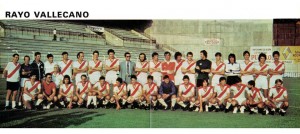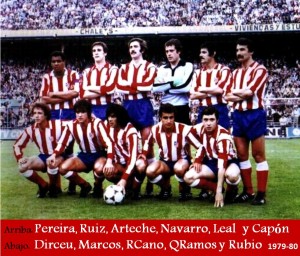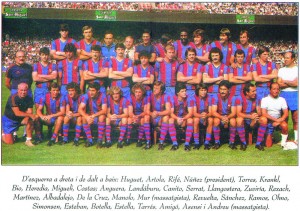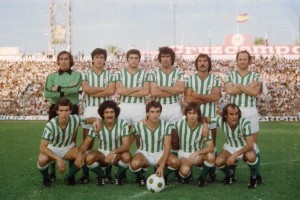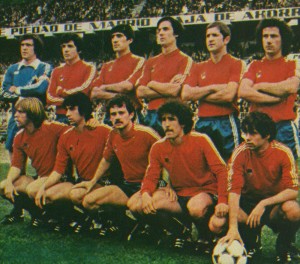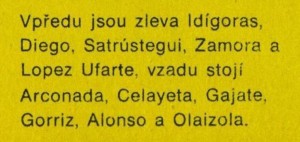The Bundesliga was the place to be, but this season the top European championship was a carbon copy of the German second division. Much stronger, of course, yet, clearly divided into 3 parts – 2 hopeless outsiders at the bottom, fairly equal main bulk, and 2 favourites way above the rest of the league.
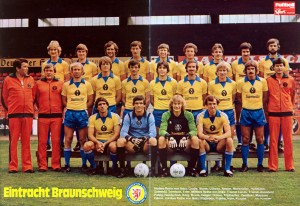 Eintracht (Braunschweig) was dead last with 20 points – hardly a surprise. They were the only team winning less than matches in this championship. They were also the only team scoring less than 1 goal per game average: 32 goals in 34 matches. The next weak scorers were Schalke 04 with 40 goals. Nothing really strange… Eintracht were never strong and their main aim was survival. Perhaps their squad explains the disastrous season: their best players were veterans, who reached their peak in the first half of the 1970s – Franke, the Yugoslavian Popivoda, and Worm. Players of the past.
Eintracht (Braunschweig) was dead last with 20 points – hardly a surprise. They were the only team winning less than matches in this championship. They were also the only team scoring less than 1 goal per game average: 32 goals in 34 matches. The next weak scorers were Schalke 04 with 40 goals. Nothing really strange… Eintracht were never strong and their main aim was survival. Perhaps their squad explains the disastrous season: their best players were veterans, who reached their peak in the first half of the 1970s – Franke, the Yugoslavian Popivoda, and Worm. Players of the past.
The other outsider was also expected failure, although such a collapse was perhaps unexpected. Werder (Bremenn) had weak 1970s, staying in the lower part of the table year after year. This year they were not even able to fight for survival – 25 points was 5 points better than Braunschweig, but also 4 points less than the 16th placed. Werder scored lots of goals – 52 – but received much more. Actually, they ended with the worst defensive record – 93 goals. The next leaky defense belonged to Fortuna (Dusseldorf) – 72 goals. Werder allowed in their net nearly 3 goals per game average!
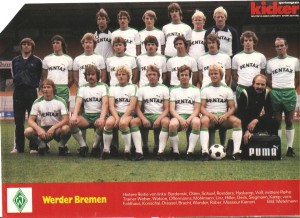 The squad was nothing much, of course, but still one can feel sorry for a newcomer – the English national team central-defender Dave Watson came to play in Germany, following Keegan and Woodcock. And immediately faced relegation… Well, Watson was hardly a stranger to second division football, but what a disappointment. With the relegation of Werder the number of the original members of the Bundesliga was further reduced – only a handful of the initial Bundesliga remained constant members.
The squad was nothing much, of course, but still one can feel sorry for a newcomer – the English national team central-defender Dave Watson came to play in Germany, following Keegan and Woodcock. And immediately faced relegation… Well, Watson was hardly a stranger to second division football, but what a disappointment. With the relegation of Werder the number of the original members of the Bundesliga was further reduced – only a handful of the initial Bundesliga remained constant members.
Nine clubs – half the league – were concerned with escaping relegation. The unlucky one was decided by goal-difference: MSV Duisburg, Bayer Uerdingen, and Hertha West Berlin finished with 29 points. Hertha had the worst goal-difference and ended 16th.
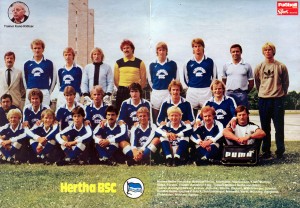 Somewhat strangely Hertha was unable to build strong team – it was notoriously up and down club, more often down. Money was a problem and may be because of that Hertha’s squads were always strange: oldish stars were frequently hired for a season or two, but serious team-building was never done. This year Kleff, one of the best goalkeepers of the 1970s, was at hand – and ones again, it was a player already beyond his peak. Of course, Kleff was not alone – there were few more good players and one of the top German coaches at the time, but chemistry was wrong. Hertha was relegated.
Somewhat strangely Hertha was unable to build strong team – it was notoriously up and down club, more often down. Money was a problem and may be because of that Hertha’s squads were always strange: oldish stars were frequently hired for a season or two, but serious team-building was never done. This year Kleff, one of the best goalkeepers of the 1970s, was at hand – and ones again, it was a player already beyond his peak. Of course, Kleff was not alone – there were few more good players and one of the top German coaches at the time, but chemistry was wrong. Hertha was relegated.
Up the table was the large group of fairly equal teams – stretched from 16th to 5th place. In the middle of the table were those already declining – Borussia Moenchengladbach (7th), Schalke 04 (8th) – those not improving for some time – Fortuna Dusseldorf (11th), Eintracht Frankfurt (9th), and 1. FC Koln (5th), and those, who were pretty much the same all the time – clubs like MSV Duisburg, VfL Bochum. Only one club was seemingly rising: Borussia Dortmund.
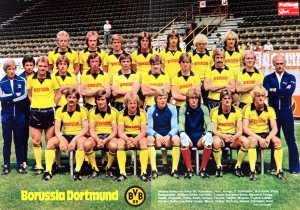 6th this season with 36 points. Not really strong, but a promising team – Burgsmuller, Votava, Geyer, Freund, Immel. Coached by Udo Lattek. Not first rate yet, but the crisis of the early 1970s was over and Borussia was seemingly on the right track. How far they would go remained to be seen.
6th this season with 36 points. Not really strong, but a promising team – Burgsmuller, Votava, Geyer, Freund, Immel. Coached by Udo Lattek. Not first rate yet, but the crisis of the early 1970s was over and Borussia was seemingly on the right track. How far they would go remained to be seen.
The ‘bulk’ was topped by slightly stronger then most teams, which competed for third place – but nothing more than that. 1.FC Kaiserslautern and VfB Stuttgart. Up and coming Stuttgart, not ready for competing for the title yet, and notoriously fluctuating Kaiserslautern, having a good season. Shoulder to shoulder to the end – the opponents finished not only with equal points – 41 – but also with exactly the same goal-difference – 75-53. Perhaps head-to-head record determined the final positions – Kaiserslautern was placed 4th.
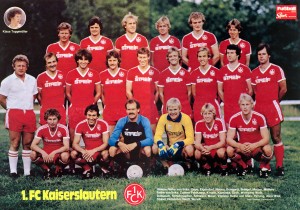 Unpredictable team, but having young promising coach – Feldkamp, and depending on strong group of players: some familiar for years – Hellstrom, Gaye, Bongartz, Wendt – and some bright young players of the next generation, rapidly becoming famous – Topmoller, Briegel, Groh. Good year, but one was reluctant to bet on the Lauters.
Unpredictable team, but having young promising coach – Feldkamp, and depending on strong group of players: some familiar for years – Hellstrom, Gaye, Bongartz, Wendt – and some bright young players of the next generation, rapidly becoming famous – Topmoller, Briegel, Groh. Good year, but one was reluctant to bet on the Lauters.
Stuttgart was lucky to get bronze medals, but they were noticed earlier as the rapidly climbing up team.
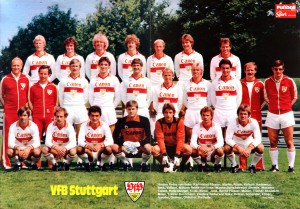 Still not the polished product – a bunch of highly promising young players: Karl-Heinz and Bernd Forster, Ohlicher, Roleder; some veterans – Volkert and the Yugoslav Holcer; and some reliable, but not great professionals like Hadewicz and the Austrian Hattenberger. And the big current star in the middle of it: Hansi Muller. Stuttgart needed a little bit further shaping, a bit of minor changes to be ready to conquer the Bundesliga. They were not yet close to best.
Still not the polished product – a bunch of highly promising young players: Karl-Heinz and Bernd Forster, Ohlicher, Roleder; some veterans – Volkert and the Yugoslav Holcer; and some reliable, but not great professionals like Hadewicz and the Austrian Hattenberger. And the big current star in the middle of it: Hansi Muller. Stuttgart needed a little bit further shaping, a bit of minor changes to be ready to conquer the Bundesliga. They were not yet close to best.
Above the league were revived Bayern and Hamburger SV – the best teams this season. They fought to the end for the title. Hamburger SV outscored Bayern by 2 goals – 86 to 84, but Bayern won 2 more matches and Hamburger SV finished 2nd with 48 points. 7 points ahead of Stuttgart – the top clubs were never concerned of any other club, but only of each other.
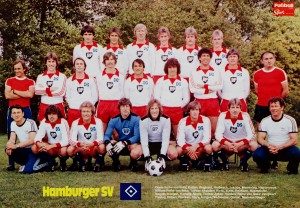 HSV perhaps lacked a bit of character, for there was no other reason for losing the title: they had the best squad at the moment. Buljan, Hrubesch, Jacobs, Memering, Hieronymus, Reimann, Hartwig, Nogly, Hidien, Kargus – a great mix of experienced veterans and talented youngsters. And three superstars – Kaltz, Magath, and Keegan. One in every line, conducting the team. Magath was perhaps the relative newcomer to stardom, but in this season he was recognized as the rival of Hansi Muller. The coach Branco Zebec needs no introduction too. Wonderful team, but they lost the title, however minimally. Character… well, everything was going to be strengthened soon – with a new coach, a master of character building and motivation.
HSV perhaps lacked a bit of character, for there was no other reason for losing the title: they had the best squad at the moment. Buljan, Hrubesch, Jacobs, Memering, Hieronymus, Reimann, Hartwig, Nogly, Hidien, Kargus – a great mix of experienced veterans and talented youngsters. And three superstars – Kaltz, Magath, and Keegan. One in every line, conducting the team. Magath was perhaps the relative newcomer to stardom, but in this season he was recognized as the rival of Hansi Muller. The coach Branco Zebec needs no introduction too. Wonderful team, but they lost the title, however minimally. Character… well, everything was going to be strengthened soon – with a new coach, a master of character building and motivation.
Bayern was overwhelming champion – 22 wins, 6 ties, and 6 losses. They scored slightly less goals than HSV and had slightly better defensive record. The rivals lost exactly the same number of fixtures – 6 each – so the title was determined by another factor: HSV ended with 8 ties and 20 wins; Bayern – 6 ties and 22 wins. Thus, 2 points of difference were built. Character won – Bayern always excelled in that. It was great moment – Bayern ended its slump, had a new team at last, andwon their first title since 1974. Their 5th title, which equaled them with Borussia Moenchengladbach, but the Bavarians were still trailing their arch-rivals by Bundesliga titles. No matter – they came back, were on winning track again, and started the new decade on top – meantime, Borussia was declining.
 Pal Csernai was instrumental, although not a coach as great as Lattek or Cajkovski. But he broke at last the stigma of the great team of the first half of the 1970s and used whatever players he had at hand well. It was different generation and Csernai utilized its strength,which was not refine andht skilful mastership of great players, but physical, determined, and disciplined approach, compensating the lack of great skills. The return of Paul Breitner was instrumental – he obviously understood well that his team-mates were not at all Beckenbauers and Mullers and proclaimed that football is a war. A war should be fought with only one objective: winning it, no matter how. Breitner took the reigns of the team, spurring it by foul language whenever he felt motivation was lacking. To a point, the new Bayern did not deserve so skilful player, but Breitner did not mind much and adapted – it was enough to have one player with skill and imagination, if the rest run like hell and keep discipline. Rummennige, the other superstar in the squad, more than welcomed Breitner – at last there was somebody to organize the flow and give great passes. The rest were largely helpers… and the whole make of the team was quite ordinary. Maier and Schwarzenbeck were out – both played symbolic role this season, no longer key players. The second raters of the old Bayern were at hand: Durnberger, Gruber, Kraus, Horsmann. Precisely the backbone of the new Bayern – they were with the team for years, always dependable and reliable, but with limited abilities. None ever became a star – they were just support players in great physical shape. And to this group were added more similar to the reliable bunch – Augenthaler, Dremler, Dieter Hoeness, Niedermayer, and Junghans. Junghans was the least satisfying – true, it was almost impossible for anyone to shine after the era of Sepp Maier, but Bayern needed better goalkeeper than only a reliable one. Junghans had a good season, but he was not a permanent solution and goalkeeping remained a problem for some time. Perhaps because the new Bayern was too mechanical and ordinary they needed great keeper – defensive mistakes happened and they were costly. As a whole, this Bayern was not exciting team to watch – they were workers, mechanical, methodical, good warriors, never giving up, but hardly pleasant to watch. The new German football was shaping – it was based not on excellence, but on determination and will. Breitner realized it and accepted the reality, but it was still too bad that he – an excellent player – had to articulate the football model of the 1980s. Run, fight, prevail, and to hell with beauty. Well, it worked… Bayern won and the more exciting team, Hamburger SV, finished below. Who can argue with winners?
Pal Csernai was instrumental, although not a coach as great as Lattek or Cajkovski. But he broke at last the stigma of the great team of the first half of the 1970s and used whatever players he had at hand well. It was different generation and Csernai utilized its strength,which was not refine andht skilful mastership of great players, but physical, determined, and disciplined approach, compensating the lack of great skills. The return of Paul Breitner was instrumental – he obviously understood well that his team-mates were not at all Beckenbauers and Mullers and proclaimed that football is a war. A war should be fought with only one objective: winning it, no matter how. Breitner took the reigns of the team, spurring it by foul language whenever he felt motivation was lacking. To a point, the new Bayern did not deserve so skilful player, but Breitner did not mind much and adapted – it was enough to have one player with skill and imagination, if the rest run like hell and keep discipline. Rummennige, the other superstar in the squad, more than welcomed Breitner – at last there was somebody to organize the flow and give great passes. The rest were largely helpers… and the whole make of the team was quite ordinary. Maier and Schwarzenbeck were out – both played symbolic role this season, no longer key players. The second raters of the old Bayern were at hand: Durnberger, Gruber, Kraus, Horsmann. Precisely the backbone of the new Bayern – they were with the team for years, always dependable and reliable, but with limited abilities. None ever became a star – they were just support players in great physical shape. And to this group were added more similar to the reliable bunch – Augenthaler, Dremler, Dieter Hoeness, Niedermayer, and Junghans. Junghans was the least satisfying – true, it was almost impossible for anyone to shine after the era of Sepp Maier, but Bayern needed better goalkeeper than only a reliable one. Junghans had a good season, but he was not a permanent solution and goalkeeping remained a problem for some time. Perhaps because the new Bayern was too mechanical and ordinary they needed great keeper – defensive mistakes happened and they were costly. As a whole, this Bayern was not exciting team to watch – they were workers, mechanical, methodical, good warriors, never giving up, but hardly pleasant to watch. The new German football was shaping – it was based not on excellence, but on determination and will. Breitner realized it and accepted the reality, but it was still too bad that he – an excellent player – had to articulate the football model of the 1980s. Run, fight, prevail, and to hell with beauty. Well, it worked… Bayern won and the more exciting team, Hamburger SV, finished below. Who can argue with winners?
